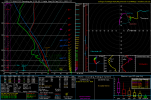...THERE IS A MARGINAL RISK OF SEVERE THUNDERSTORMS ACROSS THE LOWER
MISSISSIPPI VALLEY AND TENNESSEE VALLEY...
CORRECTED FOR TYPO
...SUMMARY...
At least isolated severe thunderstorms are expected Wednesday and
Wednesday night across the Lower Mississippi Valley and Tennessee
Valley.
...ArkLaTex to Tennessee Valley including LA/AR/MS/AL/TN...
Severe-weather potential is expected to increase into Wednesday
across the region. This will be as a shortwave trough/polar jet
spread northeastward from the south-central Plains/Ozarks toward the
Midwest and interface with an increasingly moist air mass across the
Lower Mississippi Valley/Tennessee Valley.
However, numerical guidance timing/spatial variability and the
likelihood of early day convection, as well as modest overall
destabilization, cast uncertainty regarding the potential and
placement of somewhat higher severe probabilities (such as a Slight
Risk) at this time. Recent NAM runs continue to be much more
east-northeastward progressive as compared to recent ECMWF/GFS
guidance.
Early day cloud cover and scattered thunderstorms will likely be
semi-persistent factors ahead of the cold front on Wednesday,
although most global guidance has trended slightly more unstable
with respect to the warm/moist sector over the prior 24-36 hr of
guidance runs. Regardless, currently thinking is the warm sector
will at least modestly destabilize Wednesday across portions of
Louisiana into Arkansas/Mississippi. At least an isolated
severe-weather potential should increase accordingly, including
damaging wind/tornado risks. This severe potential should reach
portions of Alabama/Tennessee Wednesday night.
An upgrade to a categorical Slight Risk could be warranted for
portions of the region into the Day 2 time frame as forecast details
become clearer.
...Lower Ohio Valley/Midwest...
Steady northeastward ejection of the shortwave trough and related
deepening phase of the northeastward-advancing surface cyclone from
the Ozarks to the Midwest could influence a strongly forced
low-topped convective line across the region Wednesday night, even
in the presence of minimal instability with northward extent. Given
a pronounced strengthening of deep-layer winds, along with
steepening lapse rates atop residual but eroding boundary layer
stability, at least low wind-related severe probabilities may be
warranted in future outlooks, even with thermodynamic
uncertainties/potential limitations.





